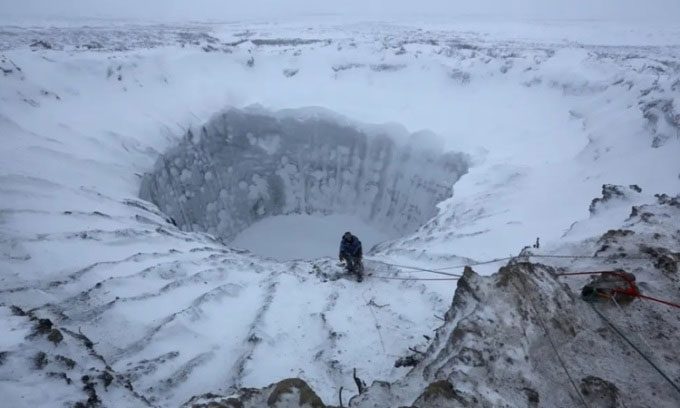Scientists have proposed a new explanation for the giant craters that seemingly appear randomly on the permafrost in Siberia.
The Strange Craters first emerged in 2012 in a remote area of Siberia, puzzling researchers. These craters can be quite large, with widths nearing 20 meters and depths of nearly 49 meters, blasting away large chunks of earth and rock that can be thrown hundreds of meters away. Some reports indicate that the explosions could be heard from a distance of 96.6 kilometers. Currently, scientists believe that hot natural gas leaking from underground reserves may be the culprit behind the explosions, as reported by Business Insider on January 15. This discovery may explain why the craters only appear in specific areas of Siberia.

An expedition member stands at the edge of a newly formed explosion crater on the Yamal Peninsula. (Photo: Reuters).
This region is known for its vast underground natural gas reserves, according to Helge Hellevang, the lead researcher and a professor of environmental geoscience at the University of Oslo in Norway. The permafrost retains a lot of organic material. As temperatures rise, the ground thaws, allowing the organic matter to decompose. This process releases methane gas.
Therefore, scientists speculate that leaking methane gas from the permafrost is the reason behind the explosion craters. This is also the process that leads to thermokarst, the lakes that form in areas where the permafrost melts, often containing burnable methane gas bubbles. However, this does not explain why the explosion craters are so localized. To date, researchers have identified eight craters, all located in the specific area of the Yamal and Gydan Peninsulas in western Siberia, northern Russia. In contrast, thermokarst lakes appear in diverse areas, including Canada.
Hellevang and colleagues hypothesize that hot gas leaks through certain geological faults, accumulating beneath the frozen layer, heating the permafrost from below. The column of hot gas contributes to thawing the permafrost, making it weaker and more prone to collapse. According to Hellevang, an explosion can only occur if the permafrost is thin and weak enough to break.
At the same time, rising temperatures cause the upper layer of permafrost to melt. This creates the perfect conditions for gas to escape suddenly, triggering an explosion or collapse mechanism under pressure. This process leads to the formation of the craters. The western Siberia region is rich in gas fields, aligning with the hypothesis put forth by Hellevang and colleagues.
According to the team’s model, many craters may be born and disappear as water and surrounding soil fill the voids. “This is a very remote area, so we don’t know the actual numbers. If you look at satellite images of the Yamal Peninsula, there are thousands of disc-shaped depressions like this. Most or all of them could be thermokarst, but they could also be previously formed craters,” Hellevang noted.


















































